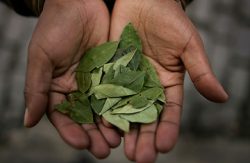What is Cocaine Made Of?
Cocaine is made of the leaves from the coca plant. Technically cocaine is the alkaloid found inside the leaves. Although there are 200 varieties of this plant, only two of them contain enough cocaine for refining. These two types are found in the mountains of South and Central America. This alkaloid is a very powerful stimulant and people used it for centuries before it became a popular high-end drug.
Unfortunately, due to its illegal nature, no one knows much about the actual cocaine plant. United States scientists often resort to studying other plants and making assumptions about cocaine. When considering what cocaine is made out of, you also have to consider how it is made, why people use it, and what the problems with cocaine are.
Call 800-934-3781(Who Answers?) toll free to find help for cocaine addiction.
How is Cocaine Made?
According to National Geographic’s article, “Secrets of Natural Cocaine Production Revealed,” people started cultivating cocaine about 8,000 years ago. At first, the indigenous people of South America chewed the raw leaf for religious and spiritual purposes. They were also chewed for energy and as a pain reliever while people worked in fields and farming.
It was not until later that the indigenous people started to strip the leaves and dry them for easier consumption. From here, it is a delicate process. If the dried leaves get wet at any time, they can start to rot. This makes them useless to those manufacturing drugs out of them.
There are three steps to the cocaine manufacturing process. These three steps are:
- Extraction phase – this is where workers extract the paste out of the dried coca leaf. This is usually done with a solvent, Kerosine, or an acid. Depending on the style of extraction, either acid or solvent, you are then left with the purest form of cocaine. The only way to find anything more pure is the leaf itself.
- Base phase – the base phase of cocaine production, chemists and manufacturers change the coca paste into a heavy cocaine base. They do this by reconstituting it with potassium permanganate and precipitating it with dilute ammonia. Once finished with this step the cocaine base is what is left after everything else is filtered out.
- Hydrochloride phase – This is the final phase and the product is a purer version of the popular street drug. Manufacturers dissolve the cocaine base again, filter it, add hydrochloric acid let it dry, and filter it again. The product of this phase is 80 to 97 percent purity cocaine.
These processing techniques vary slightly depending on the manufacturer. Manufacturers normally process cocaine in small batches so it is easy to make changes.
What Else is in Cocaine?

The main ingredient in cocaine is leaves from the coca plant.
Once cocaine is processed it stops being pure. Left over solvents, alcohols, and other substances remain in the drug. By using different substances to dry and process the cocaine the purity of the cocaine changes. The exact effect of these substances on cocaine is yet unknown but researchers are studying it. Some of these are:
- Methyl ethyl ketone,
- Acetone,
- Industrial, cleaning, or processing solvents,
- Acetate,
- Benzene,
- Methylene chloride, and
- Toluene.
Each of these can leave residue in the cocaine during processing.
Synthetic Cocaine
Synthetic cocaine is a manufactured product that mimics cocaine and is not made from the coca plant. Manufacturers of synthetic cocaine make it in labs around the world. Although there are incidents of synthetic cocaine making it onto the illicit market, it is rare. Most synthetic cocaine winds up in soft drinks and hospitals where it is used as a flavoring agent and a pain reliever.
There are illegal and legal versions of synthetic cocaine. These are made with a variety of amino acids and alcohols. Most of the synthetic cocaine formulas are kept under wraps due to copyright and patents.
Purity of Cocaine
Many things cause cocaine to be impure. Most of these are either solvents and acids left over from processing and what drug dealers use to cut down the purity. People who sell cocaine usually add something to thin out the product. They increase its volume to increase the money that they make off a batch of the drug.
Some of the things that they cut cocaine with are:
- Ethyl ether,
- Ammonia and other basis,
- Baking soda,
- Talcum powder, and
- Quinine.
Although most of these are not typically harmful, they can produce some unwanted reactions in those that are allergic.
Call 800-934-3781(Who Answers?) toll free anytime for help finding treatment for cocaine addiction.
Types of Cocaine
The addition of other substances in cocaine often changes the type of cocaine. The types of cocaine are:
- Powder – a white powdery substance,
- Freebase – a crystal form of cocaine that is not crack,
- Crack cocaine – a crystal form of cocaine manufactured by mixing it with baking soda, and
- Liquid – a rare form of cocaine manufactured by adding various liquids or melting the cocaine.
Most types of cocaine start with the original coca leaf and have things added from there.
When wondering what cocaine is made of, it is important to remember that all drugs have other things added into them. The manufacturing process does not normally change the composition of the drug, it is what is added later to maximize drug dealer profits. Although some dealers act responsibly, others do not. These substances range from relatively benign to extremely dangerous. Some will even mix the cocaine with other drugs to increase the high or add to the addiction.